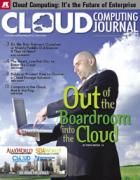Cloud Computing Is a Big Whiteboard
Cloud Computing Is a Big Whiteboard
Am I the only one who has trouble understanding Cloud Computing? Is Instant Messenger considered cloud computing? Is my company's enterprise deployment of XenApp on XenServer considered Cloud Computing? Is the iTunes store considered Cloud Computing? Why is Cloud Computing so hard to figure out? Well, look at it from a different perspective.
Have you ever laid down on the grass and looked at the sky and tried to figure out what a cloud looked like? You might think one cloud looks like a puppy and another looks like an airplane while someone else thinks your puppy looks like Homer and the airplane looks like a TV. Trying to find shapes in the clouds is all based on your perception, just like if you try to get a definition of cloud computing from 5 different people, you will most likely get 5 different ideas.
Of the many discussions I've had on this topic, I always hear some very similar comments.
- Isn't Cloud Computing just a new name for the ASP model that Citrix was involved with years ago?
- Is Cloud Computing just the new term for SaaS?
- Is the Cloud just a new name for the Internet?
Well, let's take a very brief look back before we get into the cloud...
 ASP
ASP
I think one of the problems with understanding cloud computing is many people have been involved with Citrix for a long time. If you have been involved, you will remember the ASP model. In the ASP model, a 3rd party would host your applications for you, typically providing remote access with MetaFrame. So instead of you having to hire people to manage your set of MetaFrame servers hosting Office 97, you would pay a 3rd party to do it for you. You would access your applications using a secure connection (Citrix Secure Gateway) over the Internet. You wouldn't have to worry about managing the servers or providing the data center space/power. Instead of paying these large up-front costs, you would get a static, recurring bill based on the number of servers hosted.
SaaS
After the ASP model faded into memory, we got into the SaaS (Software as a Service) model. In this model, a software vendor will host their proprietary applications to their subscribing customers. When you hear SaaS, you always hear about SalesForce.com. Well, Citrix Online is SaaS as well. Citrix Online hosts the GoToMeeting/GoToWebinar/GoToMyPC/GoToAssist services and users access these services across the Internet. Users are charged a recurring bill, and do not have to worry about maintaining and supporting the underlying infrastructure. The SaaS model has been very successful because one would expect the people who know the best way to deliver an application are the ones who developed the application to begin with.
Cloud Computing
Now we get into Cloud Computing. Cloud computing can take on many different shapes, just like the clouds in the sky. But one thing is common, all delivered services occur over the Internet, which is THE CLOUD. Cloud computing is essentially granting the ability to allow any user, on any device, from any location to get access to their applications and data.
As I see it, Cloud Computing is a big whiteboard waiting for organizations to make their requirements known. Do you want a Test/QA environment to do whatever? This is cloud computing. Do you want someone to deliver office productivity applications for you? That is cloud computing. Do you want to have all of your MP3s stored on an Internet storage repository so you can get to it from any device? That is also cloud computing.
I think the big thing with Cloud Computing, which helps differentiate it from the ASP model, is that the environment is dynamic, meaning that a server is not a SAP server or an Exchange server or a SharePoint server. A server is instead anything you want it to be with server virtualization and server provisioning. So instead of a SAP server or a SharePoint server, we now have SAP and SharePoint workloads than can be moved and provisioned to any infrastructure available. It can be scaled up or down based on changing needs and defined rules. With Cloud Computing, making these changes does not require rebuilding systems, it happens automatically and only involves resetting parameters.
If these are core requirements for any cloud provider, Citrix Cloud Center(C3) is able to help deliver the cloud-based solution.
- With Citrix XenServer Cloud Edition, we can help provide the dynamic workload provisioning
- With Citrix NetScaler, we can provide the optimized, compressed and secured connections required for Cloud-based connections
- With Citrix WANScaler, we can provide the efficient link between the cloud and the enterprise infrastructure
- With Workflow Studio, we can create and implement automated workflows that will manage and maintain the environment for us
So, the next time you talk about Cloud Computing, remember it is very similar to the dynamic clouds in the sky, Cloud Computing can be pretty much anything. One thing is common though, you need an underlying infrastructure that is dynamic, optimized, secured and automated.
http://dotnet.sys-con.com/node/805562